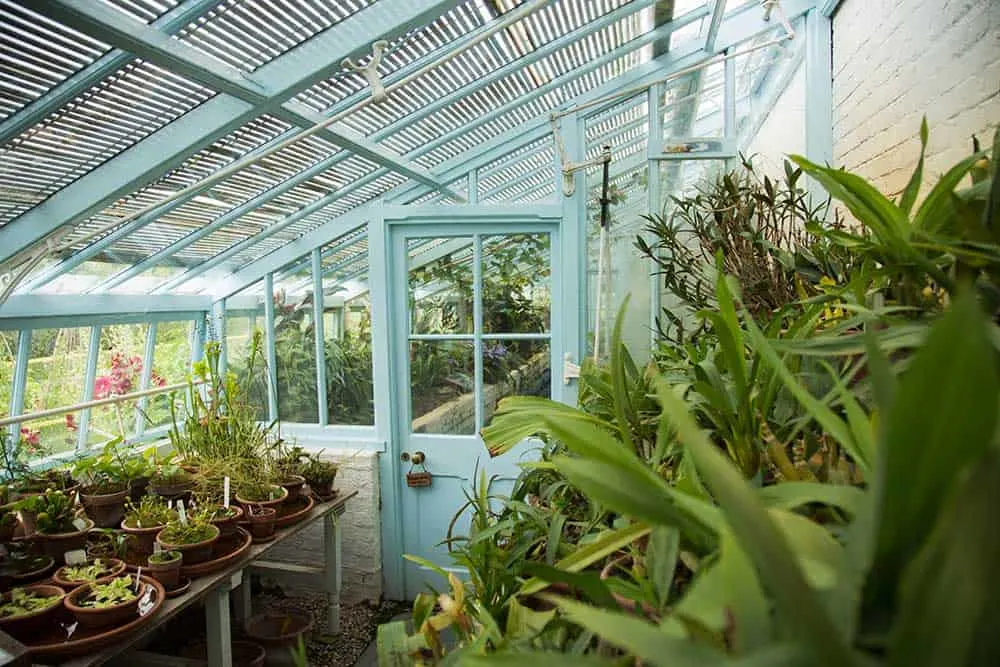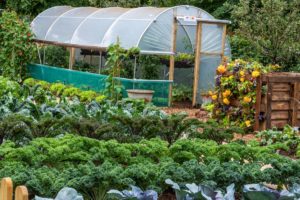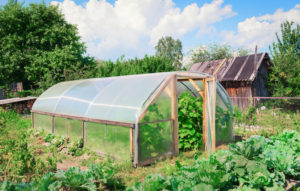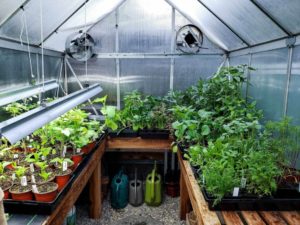As gardening enthusiasts, we all strive to create optimal growing conditions for our plants.
One of the most efficient ways to do this is by incorporating passive solar design into your greenhouse.
By strategically placing windows, vents, and insulation, you can harness natural sunlight and heat to create a thriving environment for your crops.
We’ll explore the principles of passive solar design and provide actionable tips for maximizing efficiency in your own greenhouse.
From the placement of thermometers to the installation of automatic vent openers, you’ll learn how to use nature’s resources to create a self-sustaining ecosystem that minimizes energy usage and promotes healthy plant growth.
So let’s dive in and discover the power of passive solar design for your greenhouse!
Orient the greenhouse correctly
The orientation of the greenhouse is important for maximizing passive solar design. Ideally, the greenhouse should be oriented towards the sun so that the sun’s rays hit the north-facing wall during winter, and the south-facing wall during summer.
The ideal orientation for a greenhouse is towards the sun, so that the sun’s rays hit the north-facing wall during winter and the south-facing wall during summer.
This design allows for natural light and heat from the sun to penetrate the greenhouse, providing a warm and well-lit environment for your plants to thrive.
To achieve this orientation, consider the sun’s path in your local climate.
In the Northern Hemisphere, the sun rises in the east and sets in the west, so the north-facing wall of the greenhouse should receive direct sunlight during winter mornings, while the south-facing wall should receive direct sunlight during summer afternoons.
This orientation not only provides optimal light and heat for your plants but also reduces the need for artificial lighting and heating, resulting in cost savings and a more sustainable growing operation.
By orienting your greenhouse correctly, you can harness the power of the sun to create a warm and productive environment for your plants, while also reducing your carbon footprint and energy costs.
This simple yet effective design element can make a significant difference in the success of your greenhouse and your overall growing experience.
Use thermal mass
Thermal mass refers to any material that can absorb and release heat, such as concrete, brick, or stone. By incorporating thermal mass into the greenhouse’s design, you can store heat during the day and release it at night, thus regulating the temperature within the greenhouse.
Incorporating thermal mass into the design of your greenhouse can be a highly effective way to regulate temperature and maintain a consistent environment for your plants.
Thermal mass refers to any material that can absorb and release heat, such as concrete, brick, or stone.
By using these materials in the construction of your greenhouse, you can take advantage of their ability to store heat during the day and release it at night.
This natural temperature regulation can help to maintain a stable and optimal environment for your plants, regardless of the outside weather conditions.
To incorporate thermal mass into your greenhouse design, you can consider using materials such as concrete, brick, or stone for the walls and floors.
These materials can be finished with a smooth or rough surface, depending on your preference and the specific needs of your plants.
You can consider incorporating water features, such as a pond or fountain, which can help to further regulate temperature and humidity within the greenhouse.
By leveraging the thermal mass of concrete, brick, or stone, you can create a self-regulating greenhouse that maintains a consistent and optimal environment for your plants, even in extreme weather conditions.
This can lead to improved growth and productivity, as well as reduced energy costs and environmental impact.
Incorporating thermal mass into your greenhouse design is a simple yet powerful technique for creating a more sustainable and effective growing environment.
Use double-glazed windows
Double-glazed windows provide an extra layer of insulation, reducing heat loss during the winter and heat gain during the summer. This is especially important in greenhouses that are located in cold climates or have extreme temperature fluctuations.
Double-glazed windows are an essential feature for greenhouses located in cold climates or experiencing extreme temperature fluctuations.
These windows provide an extra layer of insulation, reducing heat loss during the winter and heat gain during the summer.
This is particularly important in greenhouses, as the primary goal is to maintain a stable and optimal temperature for plant growth.
Double-glazed windows are made up of two panes of glass separated by a gap, which creates an insulating barrier that prevents heat transfer.
This means that the warmth and light inside the greenhouse will be better retained, and the outside temperatures will have less of an impact on the interior environment.
Double-glazed windows can help to reduce noise pollution and provide protection against extreme weather conditions, such as strong winds and hail.
By investing in double-glazed windows, greenhouse owners can create a more stable and productive growing environment, leading to healthier and more profitable plant yields.
Install a gutters and downspouts
By installing gutters and downspouts, you can collect and direct rainwater away from the greenhouse, reducing the risk of water damage and flooding.
Installing gutters and downspouts is a important step in protecting your greenhouse from water damage and flooding.
By collecting and directing rainwater away from the structure, you can prevent water from pooling and seeping into the greenhouse through cracks and joints.
This will not only help maintain the integrity of the greenhouse but also prevent costly repairs and replacement of damaged equipment.
Moreover, gutters and downspouts can help reduce the risk of foundation damage, which can occur when water accumulates around the base of the greenhouse.
Properly installed gutters and downspouts can also help to direct rainwater away from the foundation, ensuring that it is channelled safely away from the structure.
By redirecting rainwater away from the greenhouse, you can reduce the risk of mold and mildew growth, which can be detrimental to plant health.
Overall, installing gutters and downspouts is a simple yet effective measure that can help protect your greenhouse from water-related damage and ensure the long-term health of your plants.
Use shading
Shading can be an effective way to reduce the amount of heat that enters the greenhouse during the summer. You can use overhangs, louvers, or shade cloths to block direct sunlight and prevent overheating.
Shading is a simple yet effective method for reducing heat gain in a greenhouse during the summer months.
By blocking direct sunlight, shading techniques can help prevent overheating and maintain a more comfortable and stable temperature for your plants.
Overhangs, louvers, and shade cloths are all excellent options for shading your greenhouse.
Overhangs are a popular choice because they are aesthetically pleasing and can be designed to fit your greenhouse’s unique structure.
Louvers, on the other hand, are a more practical option that can be installed on the roof or sides of your greenhouse.
Shade cloths are another versatile option that can be positioned to provide the desired amount of shade.
No matter which shading method you choose, it’s important to ensure that it does not block too much light, as this can negatively impact your plants’ growth and health.
By carefully balancing the amount of shade with the amount of light, you can create a comfortable and productive environment for your greenhouse plants.
Use evaporative cooling
Evaporative cooling systems use water to cool the air within the greenhouse. This is a highly efficient and cost-effective method of cooling, especially in dry climates.
Evaporative cooling systems are an excellent solution for greenhouse cooling, particularly in dry climates.
These systems use water to cool the air, leveraging the principle of evaporation to dissipate heat.
By spraying water into the air, the water evaporates and cools the surrounding air, providing a refreshing and cooling effect.
The use of evaporative cooling systems is highly efficient and cost-effective, as they typically require minimal electricity and can be powered by solar energy.
These systems can be easily integrated into existing greenhouse infrastructure, making them a seamless and practical solution for greenhouse cooling.
With evaporative cooling, greenhouse operators can enjoy lower energy costs and a more comfortable working environment for their plants and employees.
Use phase-change materials
Phase-change materials (PCMs) are special materials that can absorb and release heat as they change phase from solid to liquid or vice versa. By incorporating PCMs into the greenhouse’s design, you can regulate the temperature within the greenhouse more effectively.
Using phase-change materials (PCMs) in your greenhouse design can be a game-changer for temperature regulation.
PCMs are substances that can absorb and release heat as they change phase from solid to liquid or vice versa.
These materials can be incorporated into the greenhouse’s walls, roof, or floor, allowing for optimal temperature control.
During the day, when the sun shines, the PCMs will absorb heat and melt, storing it for later use.
As the temperature drops at night, the PCMs will release the stored heat, keeping the greenhouse warm and cozy.
This natural temperature regulation can reduce the need for artificial heating and cooling systems, resulting in energy savings and a more sustainable greenhouse.
PCMs can be made from a variety of materials, such as paraffin wax, salt hydrates, or graphite, each with its own melting point and temperature range.
Choosing the right PCM for your specific climate and crop requirements can ensure optimal performance and efficiency.
By incorporating PCMs into your greenhouse design, you can create a self-sustaining and eco-friendly environment that maximizes crop yields and minimizes waste.
Monitor and adjust
Passive solar design is not a one-size-fits-all solution. Monitor the temperature and humidity levels within the greenhouse and adjust your design as needed to ensure optimal conditions for your plants.
To maximize the potential of passive solar design in a greenhouse, it is important to monitor temperature and humidity levels within the structure and make adjustments as needed.
This includes tracking the daily and seasonal changes in temperature and humidity, as well as observing the impact of various design elements such as glazing, shading, and ventilation on these conditions.
By regularly monitoring and adjusting your passive solar design, you can ensure that your greenhouse provides optimal conditions for your plants to thrive.
For example, in the winter months, the greenhouse may benefit from increased glazing on the south-facing wall to allow for more sunlight and heat accumulation.
In contrast, during the hot summer months, increased shading may be necessary to prevent overheating and reduce water loss through transpiration.
Monitoring humidity levels can help you adjust ventilation openings and irrigation systems to maintain a healthy and productive environment for your plants.
By actively monitoring and adjusting your passive solar design, you can create a greenhouse that is tailored to the unique needs of your plants and the local climate.
This approach not only ensures optimal growing conditions but also minimizes energy usage and reduces the environmental impact of your greenhouse.
Want More? Dive Deeper Here!
Hey there! If you’re the type who loves going down the rabbit hole of information (like we do), you’re in the right spot. We’ve pulled together some cool reads and resources that dive a bit deeper into the stuff we chat about on our site. Whether you’re just killing time or super into the topic, these picks might just be what you’re looking for. Happy reading!






